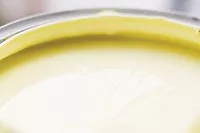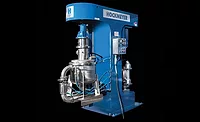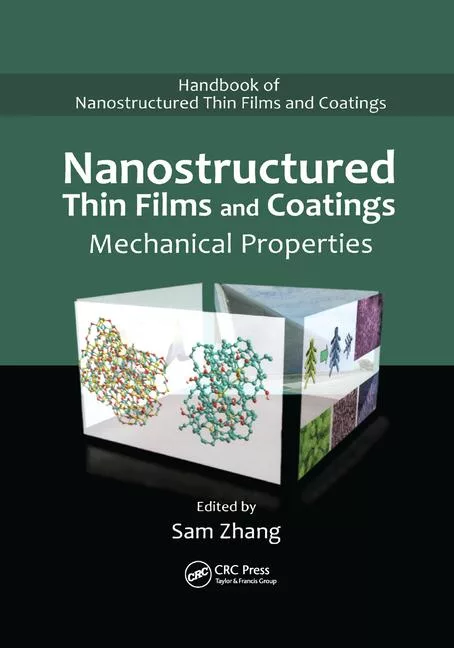Fine Mixing, Faster Processing
Processing of pigments can be optimized by choosing an efficient pre-mixer and tracking particle size even before the milling stage.

To keep pace with modern-day mass production of consumer and luxury goods, the coatings industry has hastened to update technologies and deliver different kinds of coatings for various applications that hold up to corrosion, weathering effects and tightening environmental legislations. One route to better products is the close control of particle size and size distribution since both of these parameters influence a number of important coating characteristics.
Powders have an “average particle size” as described by the manufacturer of the pigment, filler, etc. In reality, powders are often supplied in an agglomerated form so that while the average size of primary particles is 8-10 microns, the average agglomerate size might be 200-600 microns. When the powder is added to a fluid, further agglomeration can occur. Mixing and milling operations, therefore, reduce the size of agglomerates rather than primary particles. In this article, the term “particle size” is used within the above context.
The particle size of pigmented coatings directly affects optical performance by influencing parameters such as opacity, gloss, hue and tinting power. Smaller particles typically produce a more desirable product and, in combination with a narrow particle size distribution, impart a smooth, high-gloss finish. Particle size also impacts bulk properties, including rheology and stability. For example, where solids loading is kept constant, decreasing particle size not only boosts color development, but increases viscosity and improves stability of the final product as well. This can lead to reduced pigment usage.
Customer demands, in terms of finish and handling, are driving manufacturers toward finer particle size and narrower distributions, increasing the need for tightly controlled, efficient processing. This article discusses how investigators at Charles Ross & Son Company used a laser diffraction particle size analyzer (Mastersizer, Malvern Instruments) to optimize the production of a commercial ink suspension. Results show that the company’s new mixer significantly improves the efficiency of premixing/wetting out, producing a finer premix that is more rapidly milled to final product.
Formation of the pre-mix pigment dispersion is commonly carried out using propeller and turbine mixers mounted in open vessels. The capabilities of these mixers are limited to the simple wetting out of powders prior to milling. The introduction of high-speed dispersers is a welcome improvement. With tip speeds of 5,000 ft/min (25 m/s) or more, the high-speed disperser creates more vigorous flow within the vessel and imparts more shear than a propeller or turbine. This has led to significant reduction of wet-out time. However, the importance of particle size control during wet-out was not initially recognized, as the milling step was considered to be the most important in the grinding process. The wet-out stage was therefore controlled to ensure transformation of the pigment suspension into a form suitable for downstream milling, with no consideration of the requirements for the final application.
Those who now recognize the wet-out stage as a vital part of the milling process take measures to replace their propellers, turbine mixers or high-speed dispersers with more efficient equipment. Efficiency, in this case, is a measure of how well the mixer is able to disperse agglomerates of pigments as close as possible to the desired specifications. This rationale seeks to reduce the number of passes through the mill and, in some cases, eliminate milling entirely. Particle size measurement prior to milling then becomes a necessary tool for ensuring pre-mixing efficiency.
The best laser diffraction systems are highly automated, eliminating the operator variability associated with conventional particle sizing techniques such as the Hegman grind gauge. Grind gauges are widely used within the industry but only provide a measure of the largest particles in a sample. In contrast, laser diffraction analyzers measure full particle size distribution, a wide dynamic range (from 0.02 to 2,000 microns) making them suitable for every stage of the process, from wet-out through to final milled product. Measurement takes less than one minute, so it is easy to rapidly check the state of a dispersion, or track a size reduction process as it proceeds. These capabilities make laser diffraction an excellent tool for product development, scale-up, process optimization and QC.
The main downfall of these devices, and that which has discouraged many from relying on this type of equipment for pre-mixing, is insufficient flow. Conventional rotor/stators generate intense shear necessary for dispersing pigment but produce poor product flow within the vessel, resulting in localized heat concentrated on the high shear zone and the need for a jacketed vessel. The vortex generally occurs below the mixing head and is not usually strong enough to pull solids down from the liquid surface into the high-shear zone as viscosity increases.
Charles Ross & Son Company, a specialty mixing equipment manufacturer, recognized this limitation of the rotor/stator and developed the PreMax with “Delta” rotor/stator technology (US Patent No. 6,000,840). The baffle plate that typically closes one end of the rotor/stator generator is made removable and adjustable such that the rate at which solids are drawn into the mix from the surface is now controllable. The rotor is also rated to run at higher tip speeds (5,000 ft/min or 25 m/s) than a regular high-shear mixer device, creating enhanced levels of mechanical, hydraulic and cavitational shear. The “Delta” shape generates a double vortex and much greater flow than the traditional rotor design, drawing pigment powders at the surface of the mobile phase right into the high shear zone. This enhances mixing performance by eliminating the possibility of raw materials floating on top of the batch and providing a method of powder induction that minimizes dusting.
The value of the PreMax modified rotor/stator concept has been demonstrated in quantitative laboratory tests and very importantly, on actual production lines. Premixing with the PreMax generally produces results that are comparable to one or two passes through a media mill. This reduces the number of mill passes required to achieve the final product particle size, reducing processing times and production costs.

Particle size analysis using laser diffraction showed the mean particle size (D[4,3]) of a commercial ink product to be 2 mm. Dispersion of the pigment within the mobile phase using a high-speed disperser produced a pre-mix with a mean particle size of only 14.2 mm. This pre-mix contained a significant amount of agglomerated material, hence the number of mill passes required to produce the end product was significant.
Use of a standard rotor/stator high-shear mixing device during wet-out did improve the state of dispersion within the pre-mix, yielding a mean particle size of 8.2 mm. In comparison, the PreMax system yielded a mean particle size of 3.3 mm and a distribution within the acceptable parameters of a commercial dispersion. This illustrated that, using the PreMax, the manufacturer of such an ink product has the option to perform just one pass through the media mill or eliminate milling entirely, either way increasing product through-put and reducing processing costs.
 Testing in other applications showed the value
of the improvement in speed and extent of dispersion achieved using PreMax.
Particle size measurements made during wet-out show that, for dispersions of
pigmented materials such as phthalo-blue or burnt-umber, the Dv90 (particle
size below which 90% of the volume of particles exists) can be reduced to 40 mm using the system,
compared to greater than 200-300 mm
when using a traditional high-speed disperser (Figure 2).
Testing in other applications showed the value
of the improvement in speed and extent of dispersion achieved using PreMax.
Particle size measurements made during wet-out show that, for dispersions of
pigmented materials such as phthalo-blue or burnt-umber, the Dv90 (particle
size below which 90% of the volume of particles exists) can be reduced to 40 mm using the system,
compared to greater than 200-300 mm
when using a traditional high-speed disperser (Figure 2).
For more information, visit www.malvern.com and www.mixers.com.

To keep pace with modern-day mass production of consumer and luxury goods, the coatings industry has hastened to update technologies and deliver different kinds of coatings for various applications that hold up to corrosion, weathering effects and tightening environmental legislations. One route to better products is the close control of particle size and size distribution since both of these parameters influence a number of important coating characteristics.
Powders have an “average particle size” as described by the manufacturer of the pigment, filler, etc. In reality, powders are often supplied in an agglomerated form so that while the average size of primary particles is 8-10 microns, the average agglomerate size might be 200-600 microns. When the powder is added to a fluid, further agglomeration can occur. Mixing and milling operations, therefore, reduce the size of agglomerates rather than primary particles. In this article, the term “particle size” is used within the above context.
The particle size of pigmented coatings directly affects optical performance by influencing parameters such as opacity, gloss, hue and tinting power. Smaller particles typically produce a more desirable product and, in combination with a narrow particle size distribution, impart a smooth, high-gloss finish. Particle size also impacts bulk properties, including rheology and stability. For example, where solids loading is kept constant, decreasing particle size not only boosts color development, but increases viscosity and improves stability of the final product as well. This can lead to reduced pigment usage.
Customer demands, in terms of finish and handling, are driving manufacturers toward finer particle size and narrower distributions, increasing the need for tightly controlled, efficient processing. This article discusses how investigators at Charles Ross & Son Company used a laser diffraction particle size analyzer (Mastersizer, Malvern Instruments) to optimize the production of a commercial ink suspension. Results show that the company’s new mixer significantly improves the efficiency of premixing/wetting out, producing a finer premix that is more rapidly milled to final product.
Pigment Dispersion
Despite huge advances in the chemistry and formulation of pigment-based inks and coatings, industry-wide production invariably remains a two-stage process. First, the pigment is wetted-out to produce a dispersion within an appropriate mobile phase. This pre-mix sample is then milled to reduce particle size through a process of agglomerate break-up and attrition.Formation of the pre-mix pigment dispersion is commonly carried out using propeller and turbine mixers mounted in open vessels. The capabilities of these mixers are limited to the simple wetting out of powders prior to milling. The introduction of high-speed dispersers is a welcome improvement. With tip speeds of 5,000 ft/min (25 m/s) or more, the high-speed disperser creates more vigorous flow within the vessel and imparts more shear than a propeller or turbine. This has led to significant reduction of wet-out time. However, the importance of particle size control during wet-out was not initially recognized, as the milling step was considered to be the most important in the grinding process. The wet-out stage was therefore controlled to ensure transformation of the pigment suspension into a form suitable for downstream milling, with no consideration of the requirements for the final application.
Those who now recognize the wet-out stage as a vital part of the milling process take measures to replace their propellers, turbine mixers or high-speed dispersers with more efficient equipment. Efficiency, in this case, is a measure of how well the mixer is able to disperse agglomerates of pigments as close as possible to the desired specifications. This rationale seeks to reduce the number of passes through the mill and, in some cases, eliminate milling entirely. Particle size measurement prior to milling then becomes a necessary tool for ensuring pre-mixing efficiency.
Laser Diffraction Particle Sizing
Laser diffraction is a well-established particle sizing technique widely used across a range of manufacturing sectors. Particles in a sample, either wet or dry, scatter laser light passing through, producing a diffraction pattern that relates to their size. Smaller particles scatter light weakly at wide angles while larger particles produce a stronger signal at a narrower angle. A laser diffraction system detects the diffraction pattern produced, converting it to a particle size distribution via a detailed mathematical description of electromagnetic wave behavior, typically the Mie theory of light.The best laser diffraction systems are highly automated, eliminating the operator variability associated with conventional particle sizing techniques such as the Hegman grind gauge. Grind gauges are widely used within the industry but only provide a measure of the largest particles in a sample. In contrast, laser diffraction analyzers measure full particle size distribution, a wide dynamic range (from 0.02 to 2,000 microns) making them suitable for every stage of the process, from wet-out through to final milled product. Measurement takes less than one minute, so it is easy to rapidly check the state of a dispersion, or track a size reduction process as it proceeds. These capabilities make laser diffraction an excellent tool for product development, scale-up, process optimization and QC.
Maximizing Process Efficiency During Pre-Mixing
The search for more efficient mixing equipment during pigment wet-out has led many users to consider the use of rotor/stator high-shear mixing devices. These mixers consist of a high-speed rotor (with tip speeds between 3,000 to 4,000 ft/min or 15 to 20 m/s) mounted at close clearances to a fixed stator. This configuration creates intense mechanical and hydraulic shear by continuously drawing product components up into the open end of the rotor and expelling them radially through the openings in the stator.The main downfall of these devices, and that which has discouraged many from relying on this type of equipment for pre-mixing, is insufficient flow. Conventional rotor/stators generate intense shear necessary for dispersing pigment but produce poor product flow within the vessel, resulting in localized heat concentrated on the high shear zone and the need for a jacketed vessel. The vortex generally occurs below the mixing head and is not usually strong enough to pull solids down from the liquid surface into the high-shear zone as viscosity increases.
Charles Ross & Son Company, a specialty mixing equipment manufacturer, recognized this limitation of the rotor/stator and developed the PreMax with “Delta” rotor/stator technology (US Patent No. 6,000,840). The baffle plate that typically closes one end of the rotor/stator generator is made removable and adjustable such that the rate at which solids are drawn into the mix from the surface is now controllable. The rotor is also rated to run at higher tip speeds (5,000 ft/min or 25 m/s) than a regular high-shear mixer device, creating enhanced levels of mechanical, hydraulic and cavitational shear. The “Delta” shape generates a double vortex and much greater flow than the traditional rotor design, drawing pigment powders at the surface of the mobile phase right into the high shear zone. This enhances mixing performance by eliminating the possibility of raw materials floating on top of the batch and providing a method of powder induction that minimizes dusting.
The value of the PreMax modified rotor/stator concept has been demonstrated in quantitative laboratory tests and very importantly, on actual production lines. Premixing with the PreMax generally produces results that are comparable to one or two passes through a media mill. This reduces the number of mill passes required to achieve the final product particle size, reducing processing times and production costs.

Testing the PreMax System Using Laser Diffraction
The benefit of the increased shear produced during wetting-out using the PreMax system can be seen in Figure 1. An independent consultant evaluated three items of pre-mixing equipment: a high-speed disperser, a conventional rotor/stator mixer and the PreMax to determine how the particle size of an ink product changes during processing and if optimization of the wet-out stage could lead to process improvements.Particle size analysis using laser diffraction showed the mean particle size (D[4,3]) of a commercial ink product to be 2 mm. Dispersion of the pigment within the mobile phase using a high-speed disperser produced a pre-mix with a mean particle size of only 14.2 mm. This pre-mix contained a significant amount of agglomerated material, hence the number of mill passes required to produce the end product was significant.
Use of a standard rotor/stator high-shear mixing device during wet-out did improve the state of dispersion within the pre-mix, yielding a mean particle size of 8.2 mm. In comparison, the PreMax system yielded a mean particle size of 3.3 mm and a distribution within the acceptable parameters of a commercial dispersion. This illustrated that, using the PreMax, the manufacturer of such an ink product has the option to perform just one pass through the media mill or eliminate milling entirely, either way increasing product through-put and reducing processing costs.

Conclusions
Producing pigment-based coatings with a fine particle size gives excellent product performance, including better hiding power and gloss, but can be demanding in terms of processing. Maximizing the size reduction that occurs during initial wetting out reduces or eliminates subsequent milling and is, therefore, beneficial in terms of overall process optimization. Laser diffraction is a valuable analytical technique for studying pigment dispersion processes because it has the dynamic range and measurement speed required to fully characterize particle size at every stage of manufacture, and track size reduction processes as they proceed. The results presented here demonstrate its use in assessing a new mixer developed to increase productivity by improving the wetting out process, producing a finer premix that is more rapidly milled to a final product.For more information, visit www.malvern.com and www.mixers.com.
Application #1: High-Gloss White Wood Finish
Current Processing Method:- Mix bentone clay, xylene, fumed silica, titanium
dioxide, additives into alkyd resin oil in a 200-gallon tank using high-speed
disperser
- Powder Addition: 15-30 minutes
- Dispersion Time: 3-4 hours at 5,000 fpm to achieve a Dv90 of 25 microns (cooling fluid is circulated through the mix tank jacket)
- Additional Cooling: Overnight
- Let Down: Add let-down fluids and mix for 15 minutes
- Packaging: Use 2-3 bags of 50-micron filters during packaging
- Equipment: 50 HP PreMax with 8” rotor in the same 200-gallon tank
- Powder Addition: 18 minutes
- Dispersion Time: 15 minutes at 5,000 fpm achieved a Dv90 of 12-18 microns (batch temperature maintained at 50 °C with no jacket cooling)
- Additional Cooling: Eliminated
- Let Down: Add let-down fluids and mix for 15 minutes.
- Packaging: Used 1 bag of 50-micron filter during packaging
Application #2: White Wood Primer
Current Mixing Method:- Raw materials: Alkyd resins, solvents, fumed silica, clays, wetting agents
- Mix raw materials using high-speed disperser for 15-30 minutes at 5,000 fpm then pump pre-mix to a media mill (media: 2 mm zirconium silicate)
- Milling time: 4 hours (single pass with cooling; flowrate of 750-L per hour at 85% loading).
- Let Down: Milled product is pumped to a let-down tank where it joins a stream of low-viscosity material that has been mixed in a high-speed disperser for 3-4 hours
- Final Grind: Dv90 of < 40 mcirons
- Equipment: 50 HP PreMax with 8” rotor in a 300-gallon tank
- Load Time: 20 minutes
- Dispersion Time: 18 minutes at 5000 fpm, no cooling.
- Let Down: 20 minutes
- Final Grind: Dv90 < 18 microns
Looking for a reprint of this article?
From high-res PDFs to custom plaques, order your copy today!








